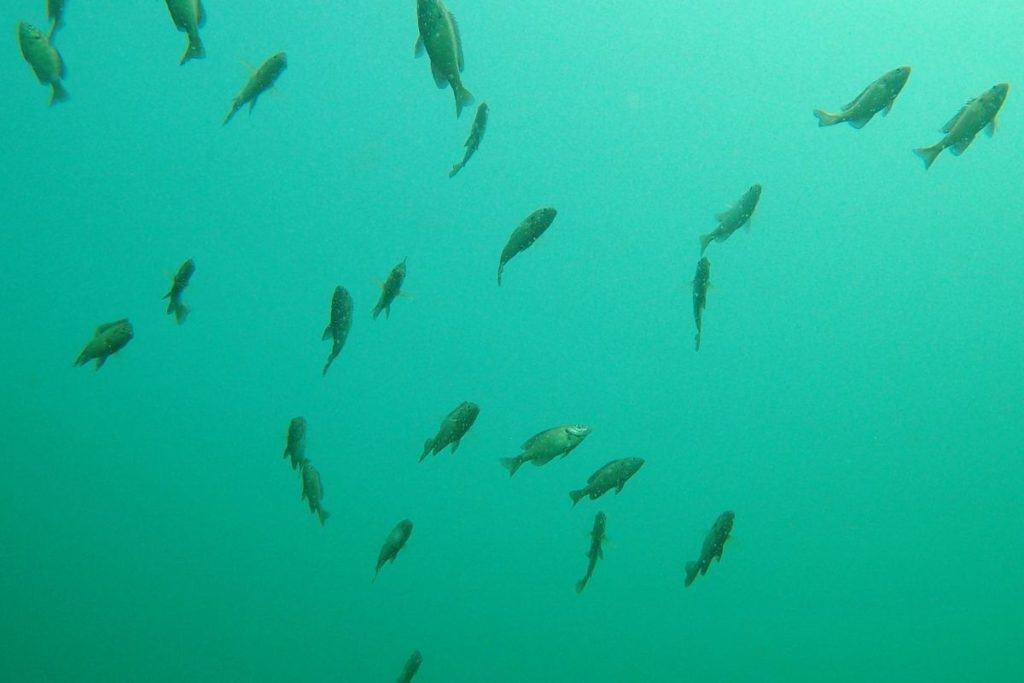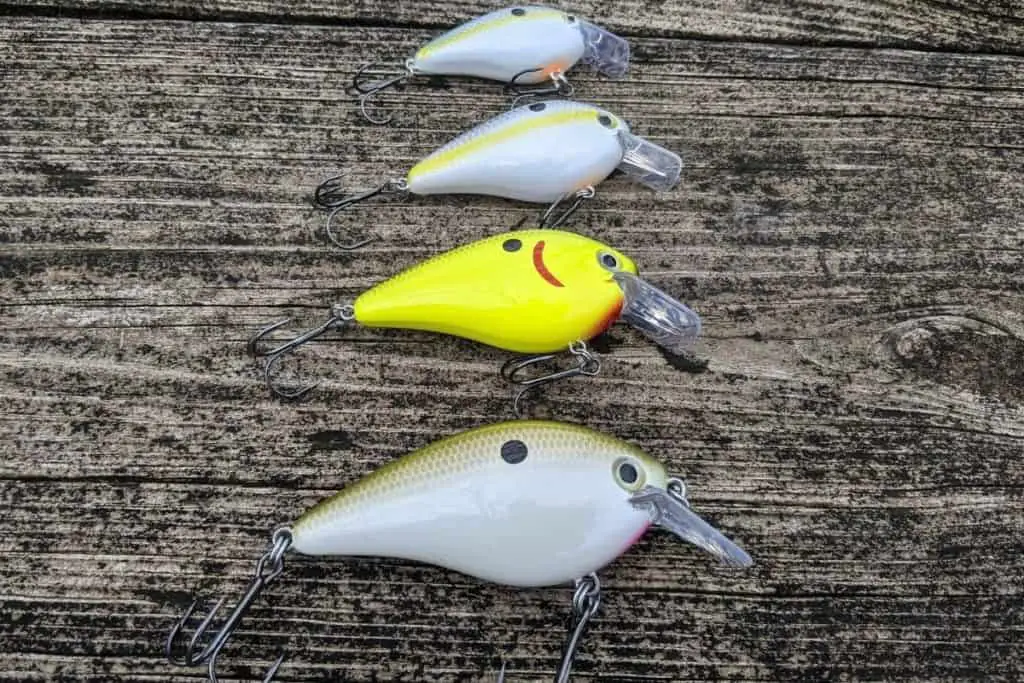Crankbaits are excellent tools for finding and catching bass. When deciding what size of crankbait to use, two factors need to be thought about.
Bass anglers need to consider the depth they want to fish and the size of the forage. Use these two factors for a starting point when selecting crankbait size.
The following will dive into detail about crankbait selection.
Using Depth as a Guide for Selecting Crankbaits
Deep diving crankbaits are in a category all their own. They are different from squarebills.
These lures are designed to hit specific depths and the body size will increase with depth.
The below chart is a depth guide for the popular Strike King XD series of crankbaits.
| Lure Model | Dive-to Depth (ft) | Lure Body Lenth (in) | Weight (oz) |
| 3XD | 10′ | 2″ | 7/16oz |
| 5XD | 15′ | 2 3/4″ | 5/8oz |
| 6XD | 19′ | 3″ | 1oz |
| 8XD | 20′ | 3 1/2″ | 1.4oz |
| 10XD | 25′ | 4″ | 2oz |
What Depth to Start At When Fishing Crankbaits
There are a couple of ways to select a starting point.
For some waters, if you can find schools of baitfish with electronics you can determine what depth they are at and start there.
Ideally, a deep-diving crankbait is hitting the bottom or really close to it. If the baitfish are suspended up in the water column, other methods are better for targeting bass hanging below the school.
When the school of bait is on the bottom of the water column, a deep diver is an excellent way to catch those bass.
(Here is an article on the best gear ratio reel for crankbaits.)

If the bottom is marked at 12 feet, I will select a lure that is rated for 15 feet.
Make extra-long casts past the intended target zone and use a low-speed reel to get the most depth and efficient action from the lure. Spooling up with fluorocarbon will also add depth to the lure since fluoro sinks.
Choosing a Starting Depth if You Cannot Find Schools of Baitfish
There is a slight difference between man-made reservoirs and natural lakes or rivers.
Dammed-up impoundments have defined creek channels that run through the lake from the intake clear to the outflow at the dam. Almost every branch and arm of the reservoir will also have a smaller feeder creek or trough from runoff.
Think about the lake before it was impounded. Can you see feeder creeks and ditches coming from the shoreline down towards the waters edge?
Finding a defined edge, or ledge, with electronics will give you an excellent starting depth. Bass love to sit on these ledges and using a deep-diving crankbait that can grind the bottom at that depth is key to locating schools of bass.

Locating a Starting Depth on Natural Lakes and Rivers
Natural lakes and rivers will also have depth changes or breaks. These are not often as defined as on man-made reservoirs, but instead will taper or slope at a more gradual angle.
An easy way to locate these changes is by looking for weeds or vegetation.
Lake weeds need sunlight to grow. Clearer water will allow for deeper vegetation growth while murky water will keep the grass line shallower.
Locating where these grass lines start and stop are key places to run deep diving crankbaits. Work the edges just as you would when fishing an impoundment.
If there is not any vegetation, use your electronics to identify the first well-defined break and use that as your starting depth.
Always attempt to keep that lure digging into the bottom of the waters you are fishing. Deep divers work best when bouncing and deflecting off of stuff. This is more apt to trigger a reaction bite.
(Here is an article talking about if bigger bass use deeper water.)
Using Forage to Determine the Best Size Crankbait to Use
Shallow running crankbaits are not as dependent on body size to reach depth like deep diving crankbaits.
This family of Strike King squarebills is a perfect example. The below chart shows that there is not a huge range. In fact, several of the lures run in almost the identical depth zone.
| Lure Model | Dive-to Depth (ft) | Lure Body Lenth (in) | Weight (oz) |
| KVD 1.0 | 2-4′ | 2″ | 3/8oz |
| KVD 1.5 | 3-6′ | 2 1/2″ | 7/16oz |
| KVD 2.5 | 3-5′ | 2 3/4″ | 5/8oz |
| KVD 4.0 | 6′ | 4″ | 5/8oz |
| KVD 8.0 | 6-9′ | 4 1/2″ | 1 1/2oz |
This is where I make my selection based on forage size.
For example, I was fishing a KVD 1.5 along some riprap on the Mississippi River a few summers ago. The only smallmouth that were eating the lure were tiny – less than a pound.
I retied with the larger KVD 2.5. The size and number of fish I started catching improved right away.
The smallmouth were keyed in on forage that was larger. By upscaling the profile of my lure I was able to present them with an offering that matched what they were eating.

Keep Adjusting Crankbait Body Size
Crankbait fishing, like all of bass fishing, is trial-and-error.
Keep adjusting the size profile and/or depth until the results show that you have found what the bass want on that particular day.
Having a variety of crankbaits in both depth and body size is important.
This can be an expensive proposition for new anglers, but don’t worry. A good selection of crankbaits happens over years of bass fishing.
And on a side note, having a solid lure retriever is always a good investment.
Another Important Factor When Crankbait Fishing
Besides depth and body profile, effective crankbait anglers understand the nuances between different lures.
Deep divers and squarebills from different manufacturers all have a slightly different profile, vibration signature, and action.
There are some days when I cannot get bit on one brand of deep diver and I will tie on another lure from another company that hits the same depth and the action is incredible.
When you are not getting bites keep experimenting until you find the right combination.
Good luck out there and be sure to encourage someone today. You never know how you may change their life forever.
Isaiah 6:8

